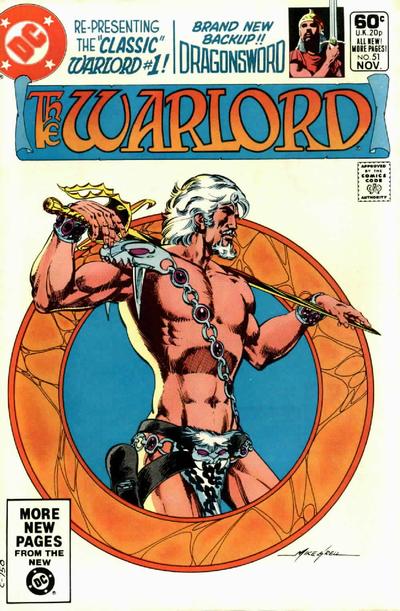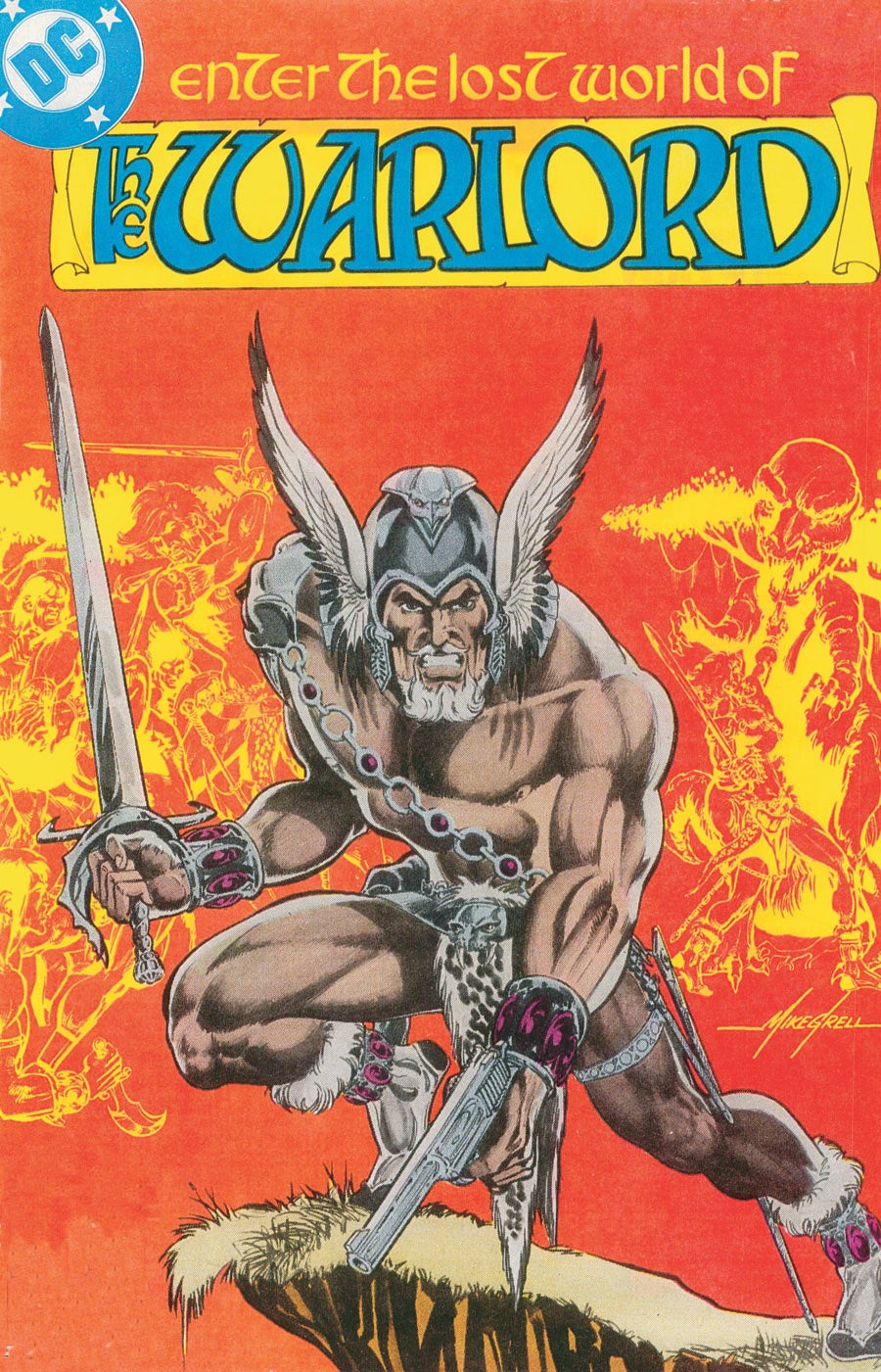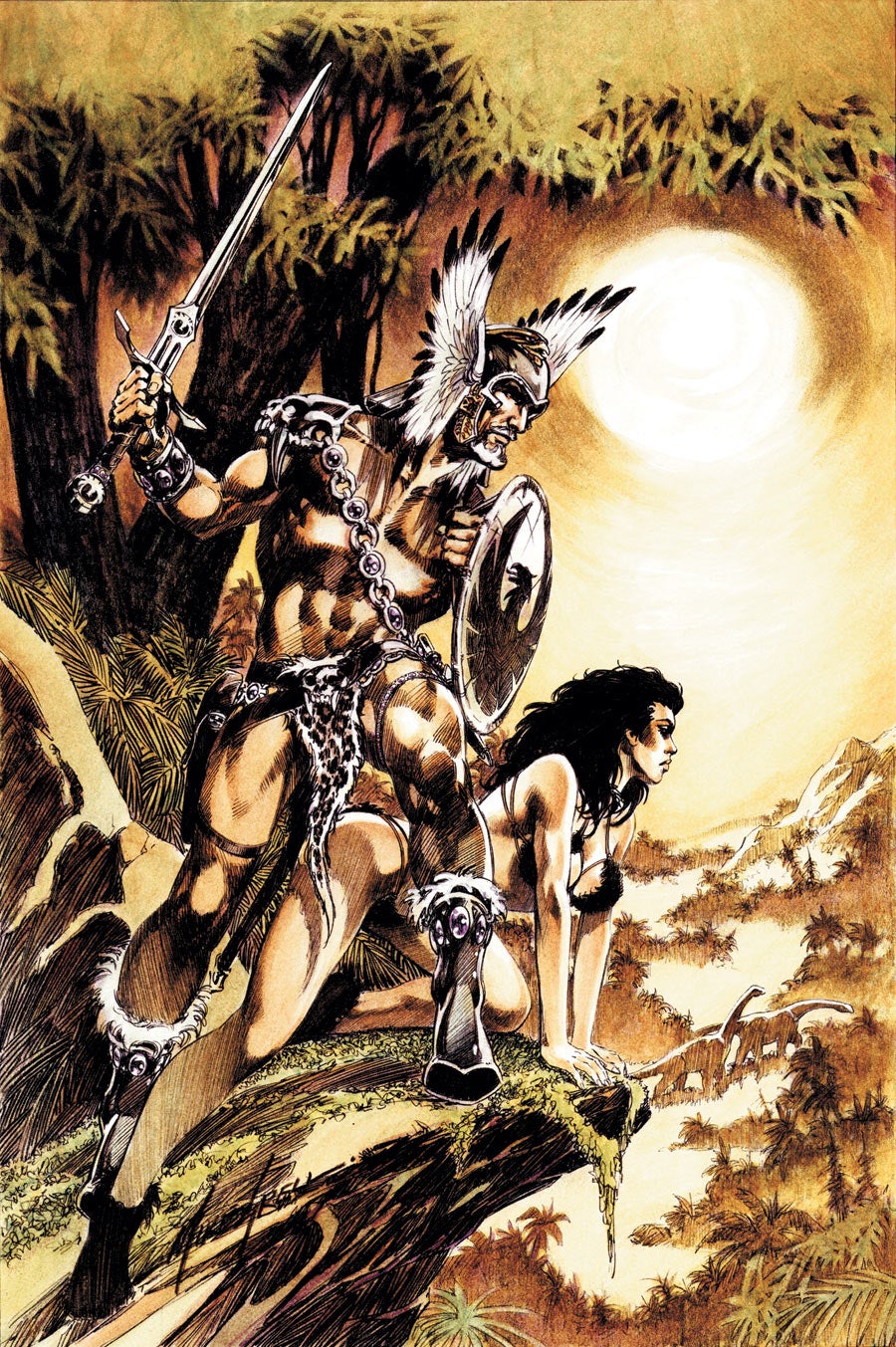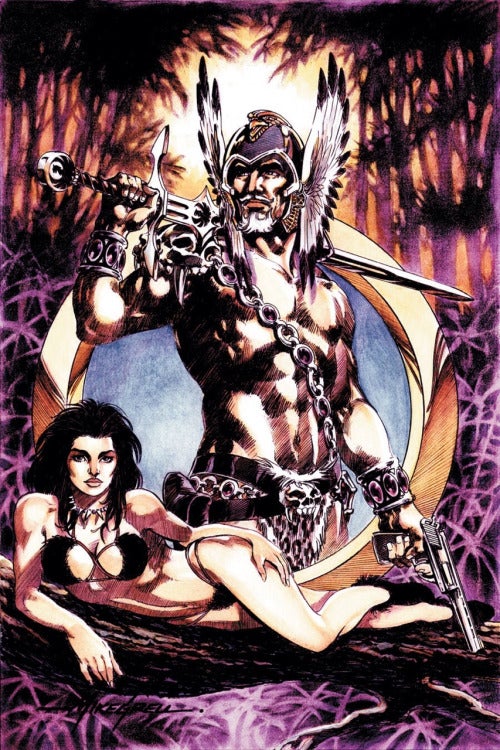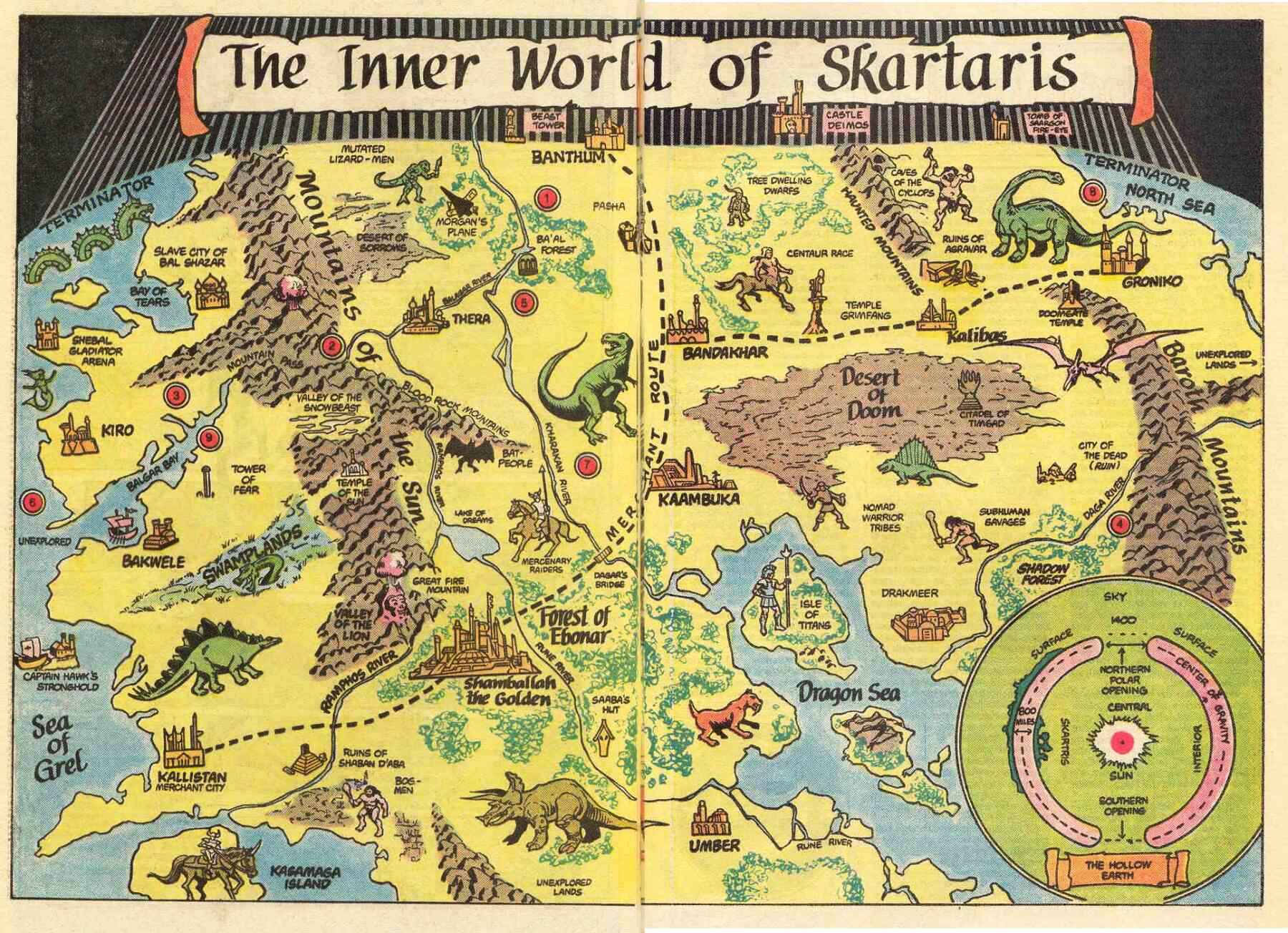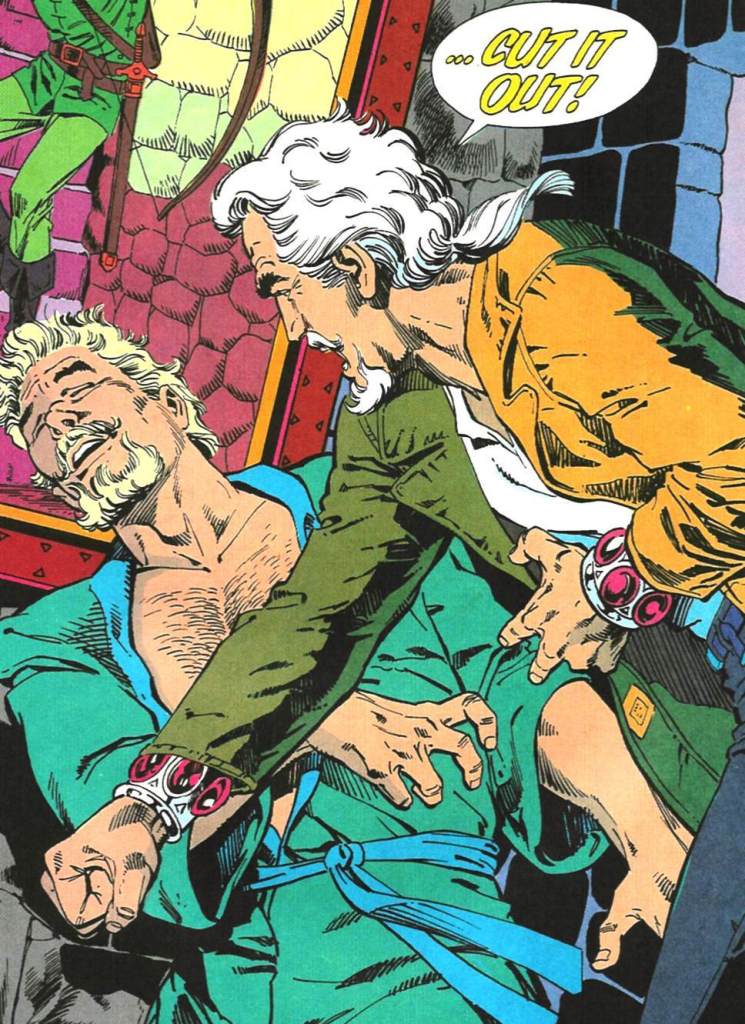Running from 1975-1988, The Warlord centered on Travis Morgan, an Air Force pilot who crashed while on a reconnaissance mission over the North Pole and ended up in a tropical, underground realm called Skartaris. Blending science fiction and fantasy, the series saw Morgan cast as a nomadic, brutal warrior who battled a powerful mystic called Deimos, armed with only his wits, a sword, a revolver and a diverse and dynamic cast of characters.
Videos by ComicBook.com
Since Grell left the series, a number of writers and artists have tried to make The Warlord work, but it never really recaptured the appeal that it had during his time on the title. Still, the characters have left a strong impression on the comic’s dedicated fan base, including the creative team behind Convergence, DC’s current mega-event in which Morgan appeared and his nemesis Deimos has been, for the first six issues, the most deadly threat the heroes have faced.
Grell joined ComicBook.com to discuss the genesis of The Warlord, what makes the character work, what makes him tick and whether we might ever see Travis Morgan back in action following his dramatic death during Grell’s return to the franchise five years ago.
The WarlordI think so. There was a certain air of experimentation. I think we were all trying to push the envelope as much as possible. Denny O’Neil and Archie Goodwin certainly did their part, Denny in particular with some of the cutting edge-type stories he did with Green Lantern/Green Arrow. For me, The Warlord was just an extension of my habitual practice of breaking as many rules as possible.
I really made it a practice throughout my career to not so much follow in somebody else’s footsteps, but try to blaze a trail as much as possible as well. The creation of The Warlord was an extension of my desire to do my own thing as much as possible. I used to say that I spent the first twenty-five years of my career trying to drive editors kicking and screaming into the Twentieth Century, and they’re just about there. You have to think ten years down the road, twenty years down the road, although these days it seems like the Big Two are only thinking in terms of two or three years. Back then, we were trying to create something that would last. It wasn’t enough to just have something that would be out on the stands for six issues or twelve issues and then go through a reboot. I think we were all trying to do something that would have a longer shelf life — something that would continue on even after we were gone.
No. I did run into that issue with the Green Arrow backup stories I was doing in Action Comics. I was teamed up with Elliot Maggin and I had stories that I wanted to do. Julie Schwartz was the editor and I persuaded Julie to allow me to do the plot and have Elliot do the dialogue. Of course, I rough-dialogued it as I went along, so that was sort of an icebreaker there.
How The Warlord came about was that I was always more interested in comic strips than comic books. Most guys who work in strips write and draw their own material, so I never saw it as a particular obstacle. I always thought that if you have enough of an imagination to be able to create interesting visual stories, it’s not that much more difficult to add the words. But it was a long learning process; I started off spouting out dialogue all over the page and then learned through working with guys like Denny O’Neil how to trim back that dialogue to the essence, really.
What happened with The Warlord, how that all came about was that I had done a comic strip called Savage Empire. Savage Empire was about an archaeologist who travels back through time and ends up in Atlantis and I had those samples in my portfolio when I went up to New York looking for a job.
Of course, I was actually trying to sell that script but I couldn’t even get through the door. Newspaper editors weren’t interested in even looking at anything resembling an adventure strip; they were only looking for the next Peanuts. Gag strips were there, guys kept telling me, “Kid, if you were here fifteen years ago, you’d have it made.” Well, thanks a lot.
I did have the good fortune of meeting some guys at New York Comic Con in ’73, where Saul Harrison was there at the time and he was reviewing portfolios and accepting submissions and things like that. I left a copy of my portfolio with him and it had Savage Empire inside.
While I was there, I ran into another guy and he asked to see my drawings — and he took a look at my portfolio and said, “You should really go talk to Julie Schwartz.”
And I said, “Can I tell him who sent me?” And he says “just tell him Irv.” It turned out to be Irv Novick. The other guy I met at that same show was Allan Asherman, who was Joe Kubert’s editorial assistant at the time. So I go up to Julie Schwartz’s office with my prepared encyclopedia salesman speech prepared: “Good afternoon, Mr. Schwartz, can I interest you in this 37-volume set of Encyclopedia Britannica complete with Yearbook and calendar,” and if you get interrupted anywhere along the way, you have to go all the way back to “Good afternoon.”
AquamanSo as time went on and I got regular assignments and more work from DC, word came down that Atlas Comics was firing up and they were going to be paying, they promised, $100 a page and creator ownership. So I grabbed my portfolio with Savage Empire and I went over to talk to them. And the editor’s name was Jeff Rovin, and Jeff looked at my stuff, heard my pitch, said he really liked it and wanted to do it. I said, “I’ve got commitments and responsibility with DC Comics and I want you to hold off any kind of announcement until I have two issues in the bag so that I don’t have any conflict there.” Fine.
So I walked from his office to DC Comics, which was about 20 minutes across town, and when I walked in the door, Carmine Infantino was waiting for me. Turns out Jeff Rovin had picked up the phone as soon as I walked out and bragged to Carmine that he had me locked up. So Carmine, who regarded himself as somewhere between the Pope and Don Corleone, was not happy with the idea that I was contemplating jumping ship. He said, why didn’t you bring it to us first? And I told him truthfully that I didn’t think DC Comics would be that interested in it because they hadn’t had any luck at all with sword and sorcery, fantasy kind of stuff. And plus, Atlas was paying so much more and creator ownership. And Carmine said, “Well, I can’t give you creator ownership, but why don’t you give me a pitch, and if I like it, what I will give you is a one-year guarantee.”
Now, a one-year guarantee from a company like DC Comics was better in my view than a shot in the dark with a brand-new company. Which turned out to be accurate becuase number one, Atlas Comics didn’t last that terribly long. None of the guys who took their own projects to Atlas Comics ended up owning any of those projects; Atlas ended up owning everything. I guess they paid $100 a page to begin with but they very quickly removed the $100 talent and replaced it with people who were earning about the same as what Marvel and DC were paying at the time.
So as I’m walking into Carmine’s office, his telephone was ringing. He excused himself to take the call and in that moment, my brain said, “You know, if you do this, you’re going to lose your project. They’re going to own it.” So while Carmine is on the phone, I basically spitballed a new pitch. I changed the name. Savage Empire became The Warlord. An archaeologist who’s transported to Atlantis became an SR-71 spy pilot whose plane is damaged on a mission over Russia and while he’s trying to find his way back over the pole, he enters the opening at the North Pole, which leads to the world at the center of the earth.
Now, I had just finished reading a book called The Hollow Earth and another of my all-time favorite books was A Journey to the Center of the Earth. I read that book probably eight times while I was in high school and saw the movie I’d guess probably 25 or 30 times already. That concept and Edgar Rice Burroughs’ Pellucidar was one of my favorite series by him. So I drew on all of this stuff. By the turn of the Twentieth Century, there had been something like 85 or 86 books written, speculating on the existence of a world within our world, the Hollow Earth theory. So I wasn’t new to it, Burroughs wasn’t new to it, Jules Verne wasn’t new to it. They were all drawing on something else that someone else came up with.
So I threw all of that into the mix and changed all the names around with the exception of Deimos. Deimos remainted Deimos because frankly I couldn’t come up with anything better. Deimos was named for the two moons of Mars, Deimos and Phobos, and so a good deal of the storyline was changed but the basic theme of it remained pretty much the same and I basically BS-ed my way through the pitch. And Carmine said “Why don’t you pitch this to Joe Orlando, and if he likes it, I’ll give you your guarantee.”
So I went in and talked to Joe. And Joe hit me with the hard question:
So what’s this guy’s name?
The Warlord.
Yeah, but what’s his name?
Morgan.
Morgan what?
Morgan The Raider. You know? Like Henry Morgan?
Well, what’s his first name?
Henry. Henry Morgan.
You can’t use that.
Well, why not?
Because there were two actors named Henry Morgan, or Henry Morgan and Harry Morgan, right? So I went “Okay. Travis.” My brother had just had a baby boy and named him Travis. So I said, “Travis Morgan.”
He went “Travis?” I said, “yeah, you know, like The Alamo?” He went, “Oh. Okay. That’s good.” And every question that he had, I had an answer for, even though I was making it up basically off the top of my head as we went along. So Joe became the first editor on the book and imagine my surprise when I delivered the third issue for lettering and I went to pick up the lettered pages the following week and I’m flipping through proofreading and I go, on the last page, there are the words “The end.”
This would have been Warlord #3. It would have been the fourth issue because the first one was First Issue Special #8.
I said, “What’s this ‘The End?’ The story continues. It’s supposed to be ‘Continues next issue.’” And Joe said Carmine cancelled it. I said, “He promised me a year’s run.” And Joe said, “Yeah, he does that,” and I was basically screwed.
Fortunately for me, Jenette Kahn came in within a coupel of weeks and basically cancelled Carmine Infantino.
Jenette was a very astute cookie. She knew the business inside and out, she knew DC Comics inside and out before she ever took over the company. And it turns out that one of her favorite books was The Warlord. When she looked at the publishing schedule, she said, “Where’s The Warlord?” They said, “Carmine cancelled it.” And she said, “Well, Carmine’s not here anymore, put it back.” And they did. And then when the implosion hit, I got really lucky because everything that wasn’t cancelled became monthly.
First Issue SpecialIt took me thirty-five years to finally get around to it, but you know, I’m half-Italian and Michael Corleone’s got nothing on me, man.
But what I was going to tell you about, BS-ing my way through the pitch, Joe said, “What’s the name of this world? What do you call it?” And I said, “It’s called Skartaris.” Now Skartaris is the name of the mountain peak in Journey to the Center of the Earth that points the way into the correct path in the volcano. When the rising sun casts a shadow on this molten peak Skartaris. And then I’m talking about the city and he says, “Well, what are you going to call the city?” I said Shamballah. And I got that from Three Dog Night, but there’s also the Tibetan legend of the golden city buried somewhere in a mountain to the north, except it’s spelled with a C and not an S. It has a lot to do with Shangri-La, as well. Skartaris is like Shangri-La in that people live an exceptionally long time because there’s no means of measuring the passage of time, and if you can’t measure the passage of time, you’re basically free.
I made Morgan older than any other DC Comics character with the exception of I suppose Alfred Pennyworth at the time, because DC was all about youth. You know? Batman’s only twenty-nine years old and nobody’s over twenty-nine years old because if you’re over thirty, you’re over the hill. I had an argument with Julie Schwartz over a line of dialogue, where Oliver Queen says, “I’m not even thirty yet.” I said, you can’t have him say that. For starters, how long has he been the guardian for Speedy? He said, probably about ten years and I said, “What court in the world is going to give a nineteen year old boy, no matter how wealthy he is, power and control over a 12- or 15-year-old boy? It’s just not going to happen.”
And I said that the same goes double for Bruce Wayne, Batman and Robin. Robin’s clearly 12 or 14 years old, 14 or maybe 15 years old in most of the stories and Bruce Wayne is supposed to be 29 and a bachelor, right? That’s absolutely not going to happen. Not in the world that we live in.
So I made Morgan older so I could do another joke like that I was planning on, where after a year’s worth of adventures in Skartaris, he boards a shuttle train in this subterranean train system that linked the various Atlantean outposts at the center of the earth with various outposts on the surface like Machu Picchu. And he comes back. In publishing chronology, the book had only been going on for a year. But he actually went down to the center of the earth in 1967 or maybe 69. I think it’s ’67 is when it starts and when he comes back up to the surface, he finds out that seven years have passed while he has no concept of the passage of time. It means that he’s now fifty years old. He’s going, “I don’t feel fifty. Do I look fifty? How can I be fifty years old?”
I had another little time paradox, a thing that I planted that really confused a bunch of people but was intentionally confusing. He had left his helmet at that station back in Skartaris and when he returns, his helmet’s still there, but it’s got cobwebs on it.
It didn’t help that when people read it, my next editor didn’t grasp the difference between Hollywood shorthand and reality. He took it literally and I had the Devil’s own time trying to persuade him that no, time doesn’t flow differently in different parts of Skartaris. That was his idea, that you could enter into a place where time flows naturally, or where it flows slower or faster. No, it doesn’t do that. It doesn’t work that way; time only exists because we have developed a means of measuring something that we call time. The reality is, time exists for us because we accept it and we live our lives by it. If you have no way of measuring time, guess what? You’re going to be forever young.
There are guys who were old before their time. A good number of my classmates when I went back for my 15th annual class reunion, they had become their parents. They were old and middle-aged even though they were only 33 at the time. It’s because they accepted age as a rule — a hard, fast number. For me, it’s only been a vague reference number; I’ve never felt my age. I’m starting to feel like, “Okay, I’m willing to accept that I’m over fifty, but not much.” The reality is that according to the numbers, I’m coming 68 this year but I sure don’t feel 68 and I sure don’t act 68. I used to brag that I’d never fallen off a horse and then when I was 45, I bought a horse, and I was falling off professionally three or four times a day, jousting with a medieval action troupe called the Seattle Knights.
You are more closely associated with Travis Morgan than almost any other creator and character at the Big Two. Typically nobody but you has had close to the same reception with the character. Why do you think that is?
I think probably because I write for an audience of one, which is me. I write the kind of stories that I like to read: high adventure, high action, some comedy, some romance. The heroes are heroic, the villains are nasty, mean, ugly, deadly and sometimes there’s an interesting twist along the way but I write for myself.
A pal who runs literacy volunteers of America did an analysis on comics to determine what sort of a reading level was required in order to be able to understand the entirety of a story. Carl Barks and I came in dead even. You have to be able to read at a fifth grade level in order to be able to understand what I’m writing.
And that fifth grade age block is interesting because that’s the time when a lot of young people are finding their way to comics, maybe for the first time, It rings a bell with them because you’re always going to have a soft spot for the comic that attracted your attention first, which is the reason superheroes were so popular and had that kind of broad appeal.
But the other thing was, if I can pat myself on the back here and say that I tried to tell the story visually that if you only had fifteen or twenty minutes you could just flip through the pages, look at the pictures, and you’d understand the story. If you had time to read it, you’ll get a little extra, but the words are supposed to help the picture, not explain the picture.
One of the things I learned working with Denny O’Neil is never, ever write something in your dialogue or caption that you’re already showing in your picture. The best bad example I can give is a Conan story. Conan is standing on the deck of a ship and there’s this tidal wave, a huge wave about to crash down on the deck. And his dialogue is “Lo! Yon mighty wave doth rise above the deck of this ship like the very hand of Crom.”
…Really?! What about “Holy s–t!” Right? You don’t write something that you’re already showing in the picture and the picture shouldn’t show something that’s already being talked about in the dialogue. It’s what made Pulp Fiction so great, is text and subtext. Two guys standing there, talking about foot rubs, when really they’re standing there getting ready to whack some guys. But it’s text and subtext. THe one has to do with the story, yes, but it’s planting seeds for something else that’s coming later on.
I suppose it’s my crowning achievement, really. I didn’t think of that entirely on my own because I know that Hal Foster really wanted to kill off Prince Valiant. He did. He was going to hand over to Prince Arn. There’s that archetypal father/son story that resonates with people over the centuries — the son fulfills the unfulfilled dreams of the father, right? The father has the dream and raises hopes but somehow fails and it falls to the son to succeed where the father fails, which is very much the case in The Warlord.
It’s like Lancelot and Galahad. Lancelot went on a quest for the Holy Grail, but he wasn’t allowed to find the Grail because he wasn’t perfect. He had been, until he decided to schtup his best friend’s wife, right? So it fell to his son to achieve where he had failed.
Arthur himself has that inherent weakness where he’s got an illegitimate son who ultimately becomes his downfall and the sins of the father sort of thing, being visited tenfold. I wanted to do that. I wanted to bring about a solid ending, and there’s a reason why I burned the body — because as soon as that book came out, DC had other writers who came in and went “Hey! I have some other ideas for a Warlord story. We can do this, or we can do that.” And God bless ’em, I have to say that they resisted that temptation.
Which is not to say that if I’m still around and drawing come the fiftieth anniversary that I couldn’t figure out a way to resurrect him in a heartbeat. I’ve basically figured it out, but for now, I’m pleased that he’s gone, I”m pleased that he’s dead and I actually quite enjoyed dealing with his son, seeing how the son would step into the role of the father and how he did. Only got another four issues to tell it in, but it was worthwhile.
Jeff King has been using them in Convergence, but of course that’s a version of the world where Morgan is still in his prime, long before your ending came for him.
Everybody has their own take, you know? As soon as I left way back when, Ross Andru was the editor at the time and he had been on me every single issue: “When are we going to get a map?” I said, “No! I’m never going to draw a map of Skartaris, because if you draw a map, right away, you establish boundaries. Why would anyone want to put boundaries on imagination?” And sooner or later, you’re going to have readers going “Wait a second, he was all the way over in this country last issue and now he’s all the way on the other side of the world? What’s up with that?” I’m not interested in how he got there, but some people are. It’s why when Conan was wandering around having his adventures, they always had to explain. Well, here he is, he’s in the desert. Well, he has to be in the desert for a long time because it’s a freakin’ desert and you’re not going to just be in the jungle next week. you know? You’ve got to travel to that jungle, and hey! There’s a story there. But I had other things I wanted to do.
Legion of Super-Heroes done your first issueAnd he was right, you know? We got mail that said “Grell, you suck!” basically. And that was the really kind stuff. So I try not to judge other guys who followed me on titles like The Warlord or Green Arrow because they’re doing their own thing. We don’t see eye to eye on a lot of stuff, but I had my chance, I made my mark and I think in the case of The Warlord, I set the bar sufficiently high that a lot of guys have stumbled trying to reach it. And that will be a good epitaph.
Arrow Smallville[Laughs] You know how that came about? That story was Dan Jurgens’ idea. He just wanted to do a story that featured both characters because he got his break on The Warlord and of course followed me onto Green Arrow. And I put my foot down. Mike Golden called me up and said, “Dan wants to do a crossover” and I said, “Oh, no, no, no. No way.” Because I always fought like hell to keep The Warlord separate from the DC Universe.
The same with Green Arrow — I took him as far out of the DC Universe as possible. And I didn’t want to do this silly crossover thing, and Golden said, “Well, look at it this way: It’s all predicated on the well-known fact that you only know how to draw one face.” That was it. I laughed my ass off, and I said “fine.”
And that’s how I wrote that story: There’s a knock on Oliver Queen’s door, he opens the door and there stands Travis Morgan, who punches him square in the jaw because he’s been in Seattle for three days and ever since he’s arrived, people have been trying to kill him thinking that he’s Oliver Queen. He goes, “Whatever you’re doing to piss people off, cut it out!”
Now, obviously because of Convergence bringing him into the spotlight so much, we should touch on them briefly too. You said that he was the only character who carried over his name from the original, Atlantis version of the idea. Was he otherwise pretty much the same character or were there a lot of changes to accommodate the reworked premise?
In Savage Empire, they are in this world of Atlantis. Atlantis hasn’t sunk yet but there’s a number of different types of cultures living there and the truth is that in my story, Atlantis is already on the decline. It has risen to a high level but it’s already on the decline in Savage Empire. In The Warlord, it’s risen, been destroyed essentially by wars and the people who are living in the cities are sort of struggling their way back to some semblance of civilization rather than being on the decline. But they’re living in the ruins of that world.
And I wanted to be able to do something where the storylines could be science fiction, could be magic, could be pretty much anything. I guess the similarity between the Savage Empire and The Warlord version of the Deimos character is that both of them have a certain amount of occult power. Deimos in Savage Empire is a high priest and he carries a lot of weight from that angle but really what people are assuming is magic that he’s using is leftover Atlantean technology that he’s discovered; he’s in the process of rediscovering this stuff and so far, he’s the only one that’s figured it out.
So if you have science that’s esoteric by the daily standards, you can attribute that to magic. In The Warlord, magic is magic and science is science but Deimos combines the two of them. In the early stories, Deimos has a book that is basically a technical manual and he’s using a combination of the Atlantean science and his own, real magic to be able to make these machines function. So it’s a twist on a twist.
I remember when Mark Waid and Mike Wieringo were doing Fantastic Four, they gave Doctor Doom magic. And I remember thinking that when you give Doom magic, he almost becomes Deimos. Do you think it’s surprising that DC took so long to use Deimos like they have in Convergence? In terms of power, it feels like he’s been overlooked and undervalued all this time.
So it’s possible to have fun with a character like that, put him into different situations. I even did a storyline where he’s been resurrected for the umpteenth time using the Mask of Life. When he’s resurrected, it becomes a story about nurture versus nature. Is he evil-evil, or is he evil because of the circumstances?
When his body is resurrected, he’s a blank slate and he has to be taught to be himself again. And for the first time, he reflects on the reasons why Morgan hates him, you know? Maybe he’s got a reason, maybe I was a bad guy! It wasn’t until things are twisted back around on him that he comes back to himself and then he is a bad guy.
The Warlord remains the first and most obvious thing that follows the name Mike Grell, in spite of your success on mainstream, big-name titles. Do you feel a special connection with these characters?
Well, The Warlord is a reflection of all my childhood fantasies. Like I said, there’s a reason why I write at a fifth-grade level and it’s because I love those kinds of stories. High action, shoot-’em-up, bang-bang kind of stuff, you know? Raiders of the Lost Ark. Now, Raiders of the Lost Ark is not Gone With the Wind, it’s not Citizen Kane, but by God, it’s one of the best movies ever. And if I had my choice of something to watch in the evening, I’d probably choose Raiders of the Lost Ark.
I like the character. The reason why he packs a .44 automag, is because I always wanted one, okay? And eventually I got one. Just like [Jon] Sable drives a ’53 Studebaker, because I always wanted one. You get to live vicariously through your characters. You just have to be a little careful on how carefully you go about carrying out the reality of it.
– – –
Want a chance to win a Batman Arkham Knight Playstation 4 Bundle? Click here or the image below to enter!
Good luck!



